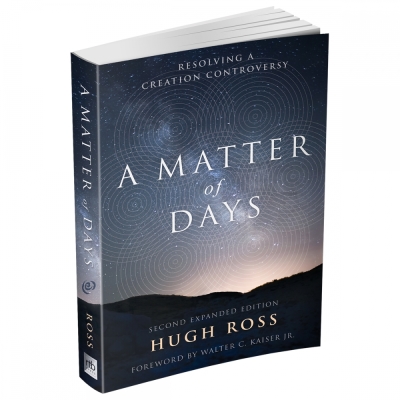Must Faithful Christians Believe in a Young Earth? A CP Interview With Christian Astronomer Hugh Ross

Must Christians who believe the scientific evidence for an old Earth also believe in a liberal reading of Scripture? This was one of the questions The Christian Post asked of Hugh Ross, whose book, A Matter of Days: Resolving a Creation Controversy, is now in a second, expanded edition.

A Matter of Days is both a critique of the "young Earth" view, that God created the Earth and universe in six 24-hour days, and an apologia of the view that there is no conflict between science and the Bible over the age of the Earth and universe. In other words, Christians can trust both the Bible and observations about the universe using scientific methods, and non-Christians can rest assured that the Christian faith is not inherently anti-science.
"The desire for reconciliation motivated this book," Ross wrote in chapter one.
As both an astronomer, with a Ph.D. from University of Toronto, and a pastor, Ross has long worked to demonstrate that science can be reconciled with his Christian faith. He founded Reasons to Believe in 1986 to spotlight the consistency between scientific evidence and scripture.
A Matter of Days was first published in 2004. The new edition contains about 50 pages of new information.
Several of the beginning chapters describe the origins of the current conflict between old Earth and young Earth creationists. This conflict, he wrote, used to be a "friendly dialogue," but has "degenerated into polarization." Ross admits feeling personally wounded at the accusations from young-Earth Christians that he is a "compromiser," or a "heretic," who does not care about salvation.
Regarding this divisiveness within the body of Christ, Ross believes, "An urgent need exists within the Church for the dawn of a bright new day."
Here is the unedited transcript of CP's email interview with Ross:
CP: Must a Christian believe in a liberal reading of Scripture, that is, assume Scripture is wrong about some things and right about others, to hold an old-Earth view of creation?

Ross: Definitely not. The Bible gives a true and trustworthy account of creation, and that account in no way conflicts with or contradicts an old-Earth view, and vice versa. Many conservative Christian theologians and biblical scholars have attested to this statement. One key is to recognize that Genesis 1:1 speaks of God's role and authority as Creator of all things, "the heavens and the earth" that we now refer to as the universe. Then, as the passage unfolds, the focus shifts specifically to planet Earth and to God's activity in preparing it for life and filling it with life. The narrator's perspective from this point onward is not "out in the heavens" but rather "hovering" over Earth's water-covered surface beneath the thick, dark clouds described in Job's account of creation (see Job 38:8-9).
The idea that a certain amount of time transpired between the events of Genesis 1:1 and the events of Genesis 1:3 (and following) comes from careful study of the original language. As Hebrew scholars C. John Collins and Rodney Whitefield explain in their writings, the structure and placement of the verbs in Genesis 1:1-3 imply an unspecified time period transpired between the creation of the universe and the initial state of Earth, and another unspecified time period passed between Earth's initial state and the first of God's works on creation day one.
Reliable Hebrew lexicons document that yôm, translated "day," has four literal definitions: 1) part of the daylight hours, 2) all the daylight hours, 3) the period from evening to evening, which we know as 24 hours, and 4) a long but finite time period. The second definition applies in Genesis 1:5; the third, in Genesis 1:14; and the fourth, in Genesis 2:4. Notice, too, that "an evening and a morning" do not constitute a full day. So this phrase serves as a marker, but most likely for something other than a 24-hour period.
Another clue comes from the lack of the "evening was … morning was" phrase in reference to the seventh day. The words of Psalm 95, John 5, and Hebrews 4 indicate that God's "Sabbath" continues, right up to the present era. Understanding this seventh day as a long time period helps explain the fossil record enigma, the fact that we see abundant evidence for speciation events (the appearance of new life forms) before humanity's arrival and virtually none since.
When I first studied the Bible in depth, I observed that Genesis 1 placed God's creation of the first male and female humans on the same day, the sixth day, and yet Genesis 2 describes a considerable passage of time between creation of Adam and creation of Eve. Adam tended the garden, named various animal species, recognized his lack of a partner, and then responded to the partner God made for him with the exclamation recorded in Hebrew as happa'am, an expression that means "at long last." I describe more than a dozen additional biblical reasons for an old Earth perspective in my book A Matter of Days. Most readers would agree that it's not enough to take the Bible literally. We must interpret it both literally (in context) and consistently.
CP: What difference does it make if Christians declare an old-Earth versus young-earth view of creation?
Ross: Because the age of the Earth makes no difference with respect to Christ's atoning sacrifice for humanity's sin or to the nature and character of God, Earth's age has no bearing on any of the historic Christian doctrines. No mention of Earth's age appears in even the most detailed creedal statements. Therefore, it should never be an issue over which Christians part fellowship.
Earth's age, however, can and sometimes does impact our effectiveness in fulfilling the Great Commission. To insist that belief in the Bible demands belief in a young Earth is to put a stumbling block in the path of many nonbelievers. It raises the question of why a God who is committed to revealing truth would make the universe and Earth measure to be old if, in fact, they are not. The book of Scripture and the "book" of nature both speak of a God who makes Himself clearly known. Jesus referred to Himself as "the truth" and to the Holy Spirit as "the spirit of truth."
CP: Are science and Christianity destined to be at odds?
Ross: What's true will never contradict what's true. Article 2 of the Belgic Confession, based on Psalm 19, Romans 1, and several other texts, declares that God has given us two reliable revelations: the words of Scripture and the facts of nature. Thus, it would be impossible for the facts of nature ever to contradict the words of the Bible. However, it is possible for our understanding of Scripture (our theology) to be at odds with our understanding of nature (science). Theology is man's attempt to interpret the words of the Bible. Science is man's attempt to interpret the facts of nature.
Because of our biases and incomplete knowledge, our interpretations can be mistaken. Therefore, when our science contradicts our theology, we know we're missing something. We need more understanding and/or more complete data. Discovering mistakes in our interpretations is one means by which we gain greater knowledge and understanding of both books.
As we read many times in Job and Psalms and elsewhere in Scripture, the more we learn about the realm of nature the more evidence we will uncover for the handiwork of God and for the supernatural accuracy of His Word. Likewise, the more we learn about the Bible, the more evidence we'll find that its revelation aligns with — even predicts — established scientific facts. I'm convinced that Christian theology and scientific findings are destined to become increasingly congruent if we remain committed to Truth.




























